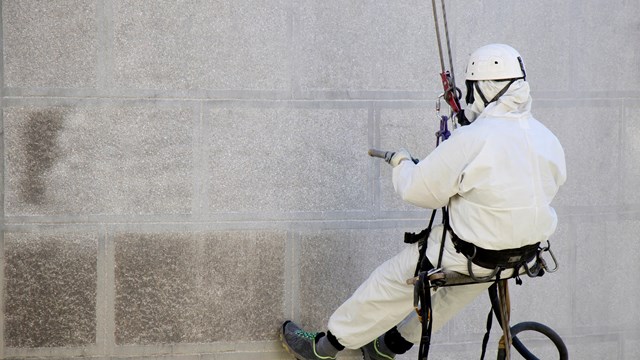The lobby of the SoHo building where Stephen DeCordova, an actor, owns a co-op is almost too small to be noticed. A tiny vestibule leads to a narrow hallway where you’ll find the stairs and elevator. Four years ago, this entryway was dark and dingy with broken-down floors. Now, a few wise decisions later, the space has an impact that is far from small. A new slate floor; walls of marble, fresco and brick; stripped steel trim and a glass wall dividing the vestibule from the hall give it a contemporary feeling. It also has something of the flavor of an old train station. On entering, you immediately feel like you’re on your way to somewhere–somewhere interesting, somewhere fun. Happily for the co-op, the stone, metal and unpainted polished plaster make the space practically maintenance-free. As designer William Fares says, "It won’t wear out, it will age."
A lobby plays an important role in both the tenants’ quality of life and visitors’ impressions. Every co-op has its own reasons for making a change. DeCordova says that his co-op began seeking ideas when he suggested they create an entryway that reflected the spaces most of them had. A building might re-do its lobby because there’s been significant member turnover and tastes have changed. And sometimes people merely want to make things more presentable. Whether you’re going for a complete renovation, or simply want to replace a worn-out carpet, you need to know what floor and wall coverings are durable, what furniture will last and what colors bring out the best in an area.
Floor Coverings
"The most durable and maintenance-free floor covering," says Gary Baydal, owner of Gary Baydal Tile Industries on Staten Island, "is ceramic; all it requires is damp-mopping." He does point out that nothing is indestructible. "Your best insurance policy is to keep two to three boxes of your tiles on hand to replace chipped ones." Natural stone has also become a very popular choice as has slate and limestone. Of those, granite is the most durable. Baydal points out that all natural stone requires sealer, which will help protect the floor from stains. Depending on the traffic, it may need to be resealed every six months to a year. Baydal doesn’t recommend using polished marble because it’s very high maintenance: the shine is created by rubbing, and it wears off quickly. However, you could obtain a 100-year-old look by using tumbled marble. This is the same marble used for polished marble, but it is put in a vat with sand and turned to obtain a dull finish. "On this kind of floor, you might not even mind stains if they contribute to the antique look," Baydal says.
To save money, you could put in vinyl tile, but it is high maintenance. You have to hire someone to come in approximately every week to wax it.
Wood flooring is quite beautiful. However, it gets scuffed and damaged easily and will require a lot of maintenance, so discuss this option thoroughly with a professional.
When opting for carpet, look for durability, a carpet with a dense, low pile. All carpets are stain-resistant to some degree. Nylon carpets are extremely durable, and many are now solution-dyed, meaning you can use stronger cleaning solutions on them and they remain color-fast. Generally, a nylon carpet comes with a ten-year warranty for wear in excess of 20 percent, provided the carpet has been properly used and maintained. (Natural fibers have warranties only for manufacturer’s defects.)
Patricia Durkan, president and chief operating officer of Durkan Patterned Carpet (a division of Mohawk) based in Dalton, Georgia, says that many corridor carpets are ruined by bleach spills from all those trips to the laundry room. In response, Durkan has just developed a bleach-resistant carpet. The company also uses a special printing process whereby they can custom-size patterns and borders, and thus provide you with carpeting that exactly fits your space and eliminates seams.
Josephine Casella, owner/manager of Starbrite Family Floor Covering in Richmond Hill, New York, recommends using carpet tiles, especially in entryways and elevator areas, because they’re easily replaced.
Professionals agree that in order to protect the beauty of your carpet and to get the longest wear from it, you must pay a lot of attention to maintenance. Katie Goldberg, the New York sales representative for Durkan, says, "Gritty dirt (and the city, in particular, has lots!) will wear down your carpet. That means a lot of vacuuming, preferably daily." Durkan says that a grated mat in front of the building to trap the onslaught of soil is essential. She also advises investing in a carpet-cleaning system for the building, so that it’s on-hand to clean the carpet every couple of months. Many co-ops do not come close to this type of maintenance; they pay the price by living for years with carpeting that’s nowhere as attractive as it could be.
Wall Coverings
It seems that many of the same materials you might use on a floor can be applied to walls. One co-op even carpeted their lobby walls! There are thousands of stylish vinyl and textile wall coverings on the market and, of course, there’s always paint. While it’s far cheaper than anything else, walls will need to be repainted every year, with scratches touched up in between. If you do decide to go this route, one solution Michael Love, president and chief executive officer of Interior Options, a firm in Manhattan that designs the interiors of everything from offices to airplanes offers is to use two-tone painting. Generally, the lower half of the wall will take the most bumping and banging, and with different shades on the upper and lower portions of the wall, you can get away with repainting only the bottom half. A wood molding usually separates the upper and lower portions of the walls and can be painted to accent the walls.
Vinyl wall coverings are very low maintenance. Richard Presedo, owner of Yonkers Paint and Decorating Supply, points out two other advantages of vinyl wall covering: it actually protects the walls themselves from getting nicked, and it offers additional soundproofing, especially welcome in hallways. "Type 2 vinyl, a medium weight wall covering, is best for public areas," advises Bruce Barkhorn of Fabulous Wall Coverings in West Orange, New Jersey. It is both washable and scrubbable (you can use a mild abrasive on it). It has different backings, often fabric, that make it extremely durable but make sure it meets the fire code for your area. Wolf-Gordon, an interior design firm in Manhattan, offers textile wall coverings resembling fine woven linen, cotton and wool that are stain-resistant and extremely durable.
A very special way to beautify a common area is with tapestries. Marsha Vander Heyden’s company, Tapestries etc. in Manhattan, offers a breathtaking selection. Pieces range from early medieval and Renaissance reproductions to contemporary originals. You can also find some African, Peruvian and Native American hangings here. Smaller ones can be hung like paintings; others are large enough to cover an entire wall. Care is simple: shake and vacuum once or twice a year; dry clean if they become really soiled.
Colors Create Ambiance
Love says that while medium colors are your best bet, "there are no hard and fast rules. She has decorated with dark tones in spaces where the lighting was great, and it worked well. Studies have shown that rooms done in cool colors (greens and blues) feel cooler than the actual temperature, vice versa for rooms done in warm colors (reds and oranges). Yellow is cheery, but too much of it can be irritating — it’s best saved as an accent, along with other intense hues. Using three colors, or shades of colors, will make your space more interesting. Too many tones beyond that will be hard to pull together.
The colors most recommended are earth tones. For one thing, they are easy to coordinate with each other. Also, their evocation of nature creates a relaxing feeling. According to Casella, "Moss green has become one of the most popular carpeting choices."
Putting It All Together
Remember, there’s lots of help available from designers and merchants, and a wide range of materials to use. If you’re clear about what your co-op wants to accomplish, the amount of money and maintenance you can afford, and particulars of traffic and lobby staff, you will be able to make choices that will stand up well. Your building will be a pleasure to come home to for years to come.







Leave a Comment